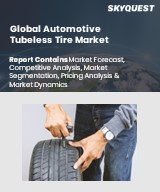
Report ID: SQMIG25B2025

Report ID:
SQMIG25B2025 |
Region:
Global |
Published Date: April, 2024
Pages:
220
|
Tables:
86 |
Figures:
72
Automotive Tubeless Tire Market size was valued at USD 173.3 Billion in 2023 and is poised to grow from USD 185.69 Billion in 2024 to USD 322.74 Billion by 2032, growing at a CAGR of 7.15% during the forecast period (2025-2032).
The tubeless tire, which is made up of a steel belt, spiral layer, and tread, helps cars perform multiple functions. Air is retained in the union of the tire and rim, and tubeless tires function without an inner tube as the outer casing forms an airtight seal with the wheel rim. It absorbs shocks from the road, changes and maintains direction of travel, and sends traction and brake force to the road surface. Moreover, a tubeless tire uses high-pressure air (nitrogen, CO2, O2, and a mixture of gases) to inflate a steel belt coated in durable rubber to perform these fundamental tasks. Due to its benefits over traditional tires, including easier puncture repair, greater comfort at higher speeds, lower tire pressure, more bump absorption, and less rotational weight, the tubeless tire market is anticipated to grow profitably over the forecast period.
In a tubeless tire, the tire and wheel rim work together to create a sealed container that holds the air inside. It is produced by exaggerating high-pressure air over a steel belt that is encircled by durable rubber. In comparison, tubeless tires are safer and more dependable. Additionally, it increases the vehicles' fuel efficiency. As a result, in recent years, the use of tubeless tires has significantly increased. One of the main factors propelling the market's expansion is the rising number of automobiles produced, as well as the improved safety and dependability provided by tubeless tires. The market is anticipated to grow more rapidly due to the simple puncture repair procedure and performance enhancement. Depending on their use and function, commercial vehicles like buses and heavy-duty trucks may have eight or more tubeless tires installed; in contrast, two-wheelers have two tires installed, while passenger cars have four tires installed.
Our industry expert will work with you to provide you with customized data in a short amount of time.
REQUEST FREE CUSTOMIZATIONWant to customize this report? This report can be personalized according to your needs. Our analysts and industry experts will work directly with you to understand your requirements and provide you with customized data in a short amount of time. We offer $1000 worth of FREE customization at the time of purchase.

Report ID: SQMIG25B2025